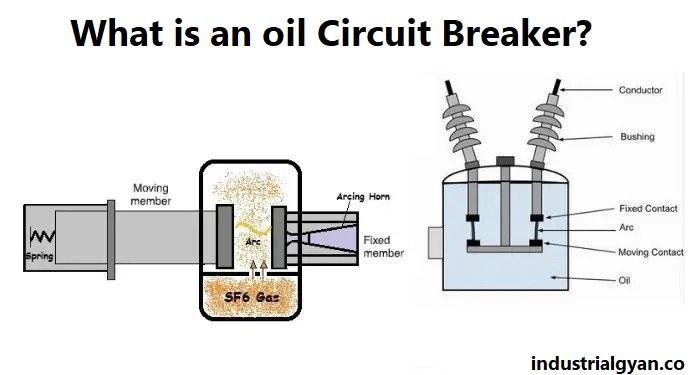Hello guys, The oil circuit breaker is used oil as a medium for insulation medium for during the switching of the circuit breaker as Arc Quenching Medium. This type of insulating circuit breaker is used for the high-voltage electrical supply. Such as power transmission, power generation, etc.
What is Oil Circuit Breaker?
An oil circuit breaker that uses the oil as an insulation medium for arc quenching medium between the terminal of the contacts. It is designed to interrupt the high voltage interrupted current in the power transmission or generation systems. When the contacts of the circuit breaker opened. The arc is produced between the contact of the terminal due to the high voltage electrical supply flowing through it. The arc then extinguishes by the insulating oil. Which cools and shortens the length of the arc. Reduce the temperature and make it easier to extinguish.

The oil also helps to prevent the re-ignition of the arc. The oil circuit breaker is mainly used in the high voltage electrical power system. where it is difficult the extinguish the arc produced by air or gas. They are reliable with a long life span. they can also withstand high temperatures produced by the arc. But regular maintenance is required and can also negative impact on the environment in case of oil leaks.
The working of the oil circuit breaker
The working of the oil circuit breaker can be explained in the following ways.
- The contact of the circuit breaker is held together in the closed position by the spring mechanism and hydraulic system. The circuit is closed until the remaining system overload or short circuits in the electrical system.
- When the fault occurred the contact opened. The circuit breaker terminal is open and powered by the motor or spring mechanism.
- As the contact separates, the arc is produced between the contact of the terminals due to the high amount of the current flowing through a gap of the contacts.
- The arc produced during the opening of the contact extinguishes the oil. The oil helps in cooling and length short of the arc. The low temperature of the arc help in easier to extinguish the arc.
- The arc is quenched. The oil vaporizes between the contact of the terminal due to the high temperature of the arc. This creates high pressure in the arc zone.
- The oil that is used in the circuit breaker is required to must be of good insulating material and have a good flashing point. The flash point is the temperature at which the oil will ignite if exposed to an open flame.
- The oil circuit breaker also is including a number of safety features to prevent damage to the circuit breaker or In the electrical system.

Oil circuit breakers diagram
Construction of the oil circuit breakers
The construction of the oil circuit breaker can be explained in the following steps.
- Tank:- The tank is a steel vessel that houses the oil and other components of the circuit breaker. It is designed to withstand high pressure and contain any oil that may leak from the circuit breaker.
- Contacts:- The contacts are the components that carry the electrical current in the circuit breaker. They are typically made of copper or metal-made conductive materials.
- Arc Chute:- The arc chute is a set of metal plates that are arranged in a stack to create a path for the arc produced when the contacts of the circuit breaker are opened. The arc chute is designed to split the arc into smaller arcs and to increase the surface area of the arc. It helps to cool and extinguish the arc.
- Insulating Oil:- The insulating oil is a dielectric fluid that is used to insulate the contacts of the circuit breaker and to quench the arc when the contacts are opened. The oil is typically a mineral oil or synthetic oil with a high flash point and also good electrical insulating properties.
- Operating Mechanism:- The operating mechanism is the component that opens and closes the contacts of the circuit breaker. It is most typically powered by a motor or a spring mechanism.
- Control System:- The control system is a set of switches and relays that are used to control the operation of the circuit breaker. It includes safety features such as pressure relief valves and alarms that are used to protect the circuit breaker and the electrical system.
Application of the oil circuit breakers
The Oil circuit breakers are used to commonly for high-voltage power systems to prevent overload or short circuit current.
- Power transformers:- Oil circuit breakers are often used to protect power transformers from overloading and short circuits or over current. They can interrupt high fault currents and protect the transformer from damage and such another type of electrical threats.
- Generator protection:- Oil circuit breakers can also be used to protect generators from electrical faults that can damage the equipment or cause power outages.
- Substations:- Oil circuit breakers are commonly used in high-voltage substations to protect transmission lines, transformers, and other electrical equipment.
- Industrial applications:- Oil circuit breakers are used in most industrial applications where high voltage is required, such as in steel mills, chemical plants, etc.
For more information click here Industrial Gyan
You can follow us on LinkedIn

I am a highly motivated and skilled individual with a passion for Electrical engineering. I have 1 year of experience in Robotics and Electrical engineering, which has allowed me to develop a strong set of skills in PLC, Painting Robots, SCADA. I am a quick learner and am always looking for new challenges and opportunities to expand my knowledge and skills. I am a team player and enjoy working with others to achieve a common goal. Successfully completed many projects for a various clients in the automobile sector.
Thank You

